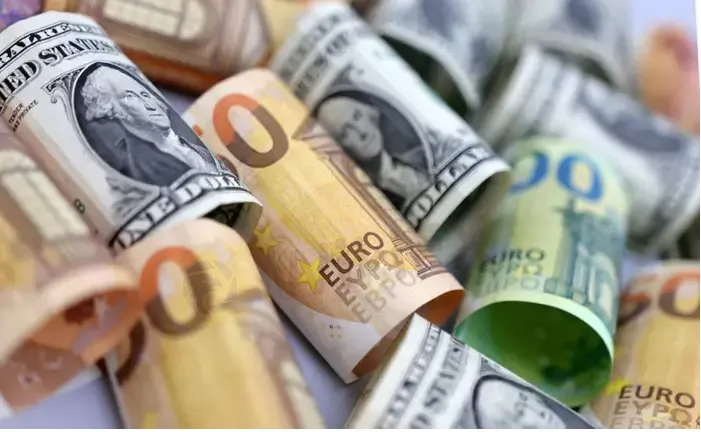简体中文
繁體中文
English
Pусский
日本語
ภาษาไทย
Tiếng Việt
Bahasa Indonesia
Español
हिन्दी
Filippiiniläinen
Français
Deutsch
Português
Türkçe
한국어
العربية
Dollar resilient, euro wallows at two-decade low on economy woes
Abstract:The dollar held firm on Tuesday on safe haven flows, while the euro languished around a two-decade low as investors braced for a hard winter in Europe as it grapples with energy supply and broader economic growth concerns.

The euro touched its lowest since late 2002 of $0.9926 overnight and was last barely higher at $0.9941.
Russia will halt natural gas supplies to Europe via the Nord Stream 1 pipeline for three days at the end of the month, the latest reminder of the precarious state of the continents energy supply.
Heatwaves in the continent have already put a strain on energy supplies and worries are growing that any disruption during the winter months could be devastating for business activity.
“Given the current mood, there‘s obviously concerns as to whether that’s going to be three days or whether its going to be three years,” said Ray Attrill, head of FX strategy at National Australia Bank (NAB).
“Is it really just going to be a three-day maintenance or is this just another example of weaponisation of gas supply into Europe?”
The pound was also dragged to a new 2.5-year low overnight, and hobbled near that level at $1.17715 in Asia trade. The Japanese yen steadied at 137.265 per dollar after touching a one-month low of 137.705.
Conversely, the Australian and New Zealand dollars were relatively steady, which NAB‘s Attrill attributed to the market’s attention being drawn to the weakness of Europes outlook.
Chief on investors minds for Tuesday will be flash manufacturing PMI readings out in the euro zone and Britain later in the day, which will provide further clarity on the growth trajectory for the respective economies.
Investors are also waiting on minutes of the European Central Banks (ECB) last policy meeting on Thursday that are likely to sound hawkish even as the continent faces a downturn in growth.
The Aussie was up 0.28% at $0.6898, while the kiwi also gained 0.28% to $0.6190. [AUD/]
Elsewhere in Asia, the dollar traded at 6.8652 against the offshore yuan, not far from a nearly two-year high of 6.8752 hit on Monday.
Against a basket of currencies, in which the euro is the most heavily weighted, the U.S. dollar index stood firm at 108.9, attempting to breach a two-decade high of 109.29 hit in July.
Another reason investors have sought shelter in dollars is the growing risk of a hawkish message from the Federal Reserves Jackson Hole symposium, flagged by several officials last week.
“Bonds sold off, led by the front-end,” said analysts at ANZ. “That‘s possibly in anticipation that Chair (Jerome)Powell’s speech on Friday is likely to reiterate hawkish messaging.”
Yields on the benchmark 10-year Treasury note have risen about 4 basis points for the week and last stood at 3.0165%. Yields on the two-year Treasury note were up around 5 bps at 3.3102% as investors remained on inflation and Fed-watch mode.

Disclaimer:
The views in this article only represent the author's personal views, and do not constitute investment advice on this platform. This platform does not guarantee the accuracy, completeness and timeliness of the information in the article, and will not be liable for any loss caused by the use of or reliance on the information in the article.
Read more

WikiEXPO Dubai 2024 is coming soon
3 Days Left!

Trader Exposes Unethical Practices by STP Trading
A recent allegation against STP Trading has cast doubt on the firm's business practices, highlighting the potential risks faced by retail traders in an increasingly crowded and competitive market.

What Makes Cross-Border Payments Easier Than Ever?
Cross-border payments are now faster, cheaper, and simpler! Explore fintech, blockchain, and smart solutions to overcome costs, delays, and global payment hurdles.

WikiEXPO Dubai 2024 is set to open!
4 Days Left
WikiFX Broker
Latest News
Webull Partners with Coinbase to Offer Crypto Futures
eToro Expands Nationwide Access with New York Launch
Why Is UK Inflation Rising Again Despite Recent Lows?
Hackers Charged for $11M Crypto Theft Using SIM-Swaps
Role of Central Banks in the FX Market
FCA Alerts Against Sydney FX
What Makes Cross-Border Payments Easier Than Ever?
Trader Exposes Unethical Practices by STP Trading
Interactive Brokers Launches Tax-Friendly PEA Accounts in France
Google Warns of New Deepfake Scams and Crypto Fraud
Currency Calculator


